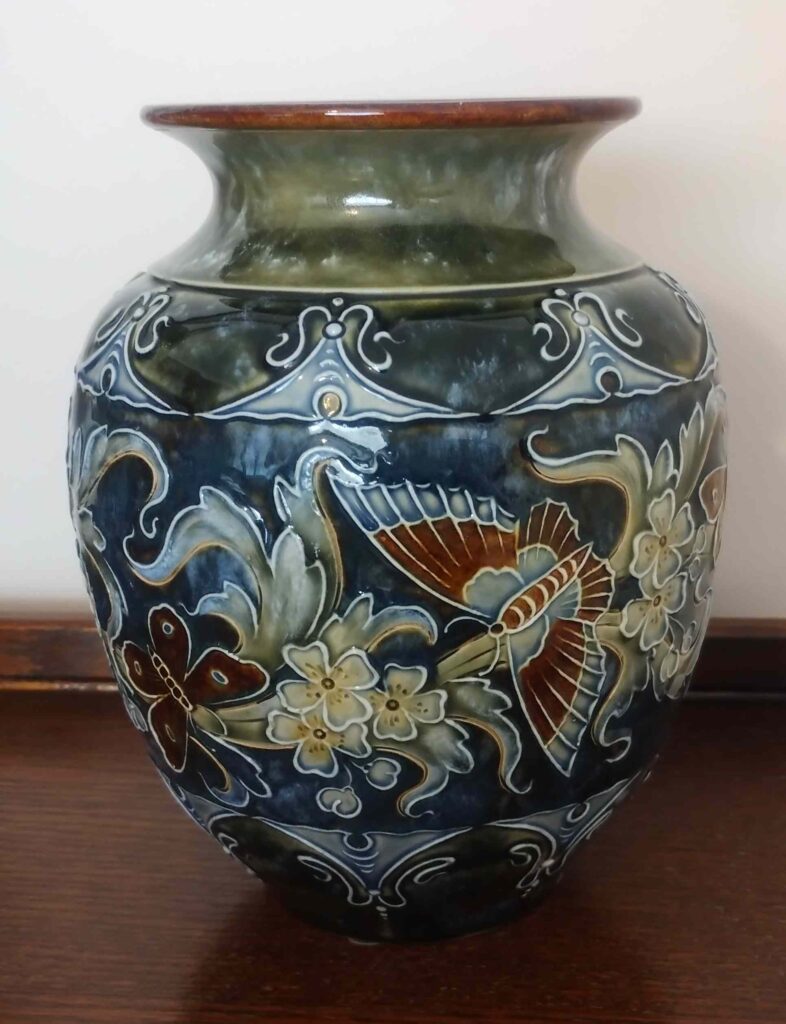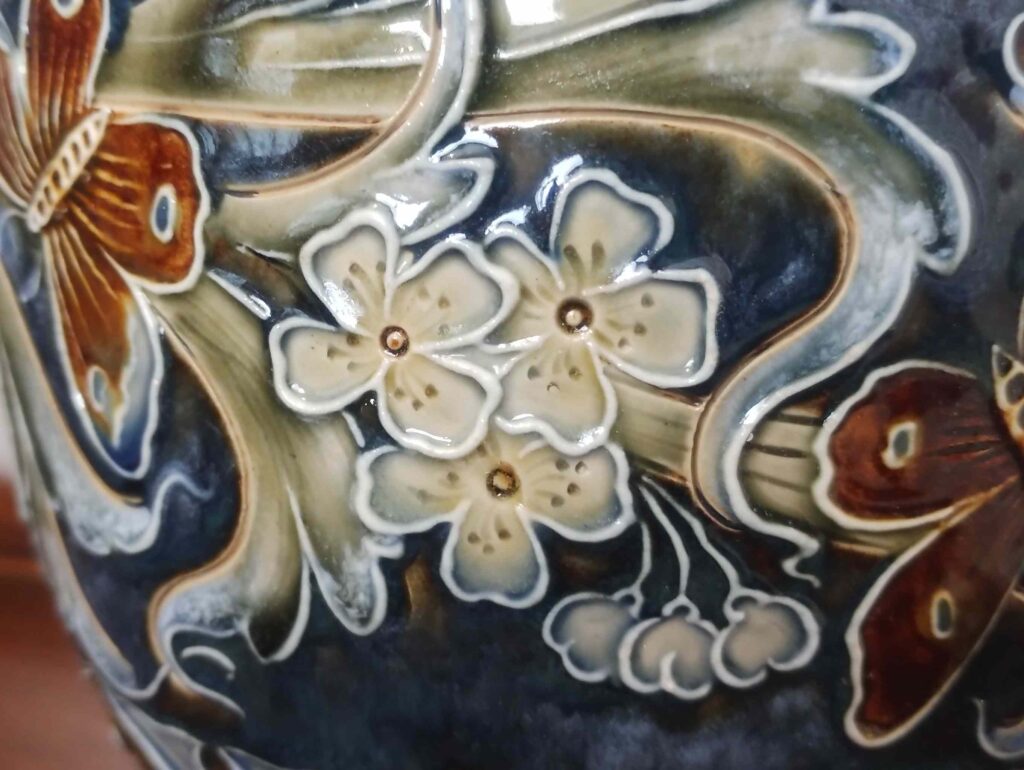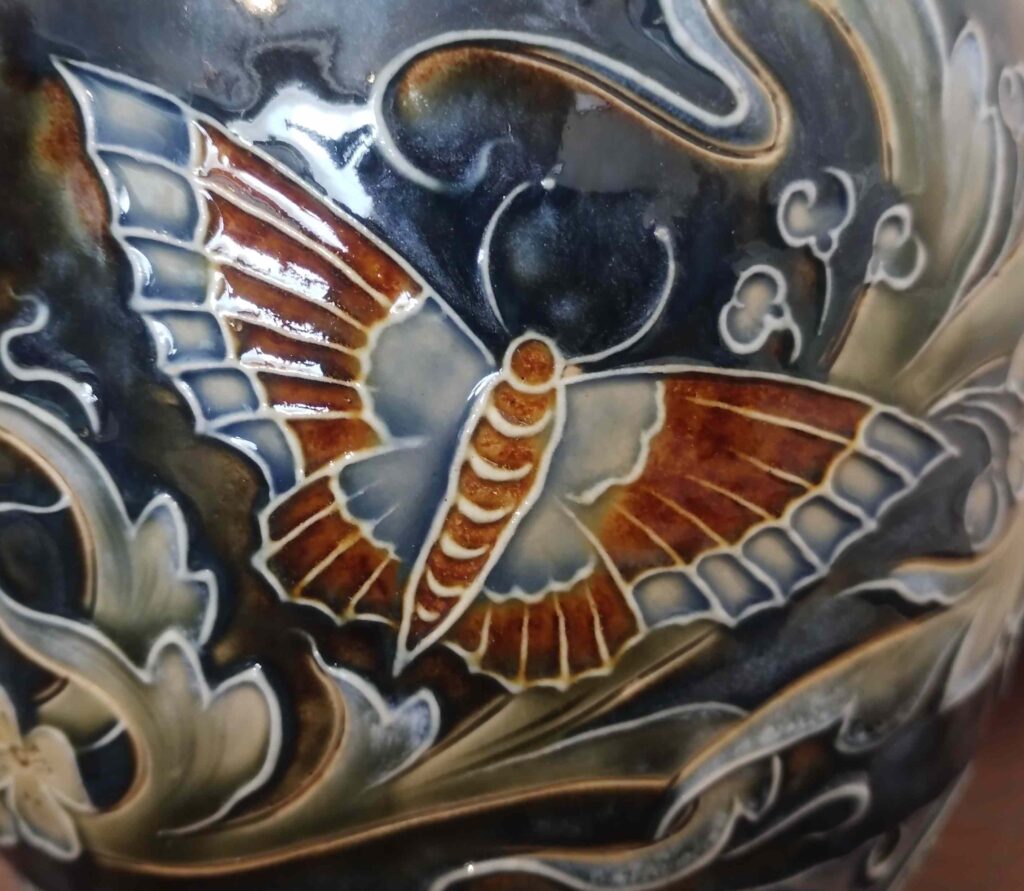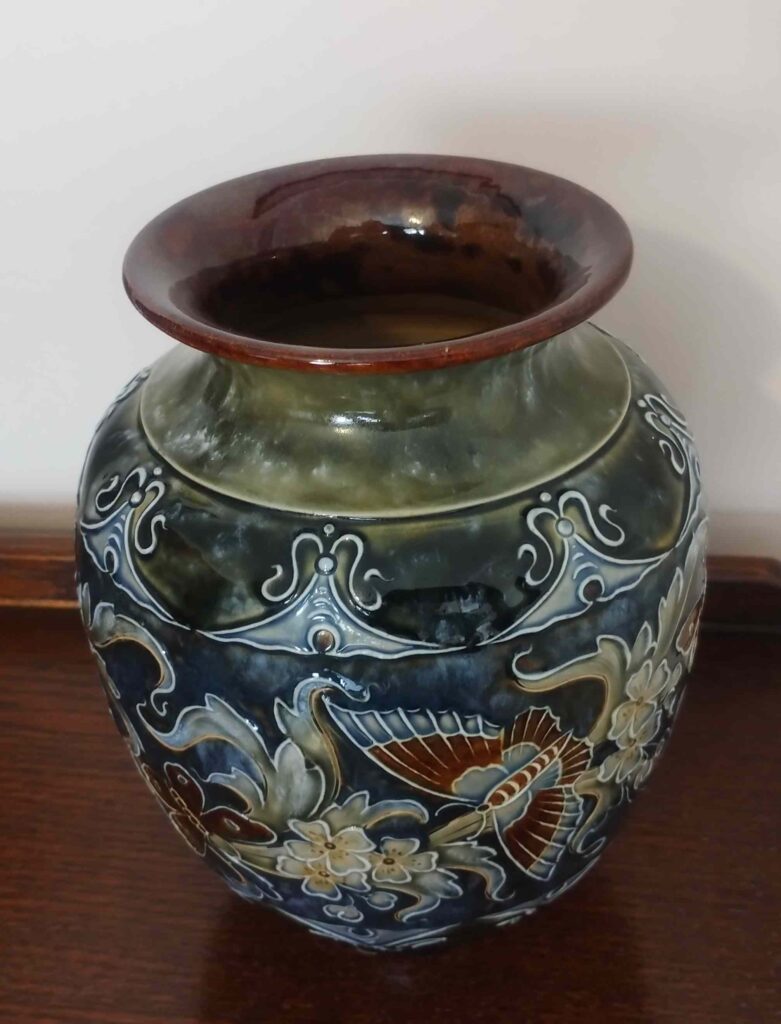
Our collection of ceramics isn’t large but it changes over time as we purchase new pieces and decide to sell on some we’ve had for a while. We rarely tire of a piece, but the available space limits what you can keep and display at any one time. However, the collection does include a few items that I can’t imagine selling. This posting is about one of these; a vase by Eliza Simmance, for Doulton.
Almost a missed opportunity
I first saw the vase in April 2024 when we were selling at the Stoneleigh Antiques Fair. Not far from our pitch, Julian Eade had set up his display. I’d seen Julian at fairs such as NEC and other high-end shows but I’d never taken time to speak to him. In truth I was slightly star-struck. Julian sells the best pieces of early Doulton ceramics that you’ll see outside museums. He’s also one of the few people I’ve seen who regularly displays Martin Brother’s work for sale. If you fancy spending several thousand pounds on a “Wally Bird” at an antiques fair, Julian is usually able to help.
When I introduced myself, Julian turned out to be disarmingly laid back, charming and polite. When I asked if I could have a look around his display he was quite happy to leave me to it. Julian knows his stock sells itself. It didn’t take long to pick out the vase in question and over the two days of the fair I returned several times to look at it.
And then at the end of Day 2 of the fair, we just packed up and went home. We’d not had a great show, it was OK, but the organisation of the fair had been poor and footfall on the final day was very disappointing. I wrote at length about the experience. I was probably a bit grumpy, I was certainly tired. That’s never a good time to expect a Yorkshireman to spend money.
By the next day, having had a decent sleep and lie-in, I felt annoyed with myself over not buying the vase. My consolation was that I knew I had the chance of a second opportunity to buy it. A couple of months later we were at the Classic Antique Fair at the NEC, this time as buyers. As hoped, Julian was there again with his display and so was the vase. I didn’t mess around this time and bought it straight away. It would have been unbearable for someone else to have bought it before I made up my mind again.
The Vase – a description
This stoneware vase is a product of the famous Doulton Pottery art studio in Lambeth, by designer Eliza Simmance. The vase is baluster shaped and is adorned by tubelined decoration.
The vase stands about 25cm high. The body decoration consists of leaf-like swirls, simple flowers and five butterflies. Above and below the broad band of decoration are two narrower, complementary bands in a distinctly Art Nouveau style. The main body of the vase uses a bluish glaze as the background colour
The neck of the vase has a plain band of the finest mottled/cloudy glaze that I’ve seen on Doulton ceramics of this era. This is nominally greenish of a hue that complements the bluish body to perfection. The throat of the vase is finished in a subtle, mid-brown glaze.
So far as I am aware, the vase is free from any damage. Despite being about 130 years old it looks like it came out of the kiln yesterday.
For readers interested in such things, the depicted invertebrates have a distinct ‘club’ tip to their antennae. As such I believe them to be representation of butterflies rather than moths. They are not however representative of any particular species as far as I can tell.
So what makes the vase so special?
Everyone has their own tastes, so some people might not appreciate the vase. For me though, this is the epitome of a perfect piece of ceramic art.
So where do I start? Standing back, I’m always drawn to a good sized, baluster shaped vase and this vase has a lovely, balanced and tactile shape. I like much of the art ceramics produced at Doulton prior to about 1930 but in their desire to be “different”, sometimes the designers got a bit weird in the pot shapes. Excessively tall necked vases or vases with (for me) mis-proportioned bodies and necks seem to abound. You see quite a lot of these in auctions. I suspect these are the ones that people today decide not to keep and so they end up for sale.
The best pieces of early Doulton don’t usually end up in auctions. You need to buy directly from people such as Julian Eade who get offered whole collections at a time. This gives him the chance to pick out the best pieces for direct (re)sale.
Coming closer to the vase you start to see the colours of the glazes. Doulton had a range of colours they could create with a salt glaze coating. Here the mottled blue and green are shown at their best. They are quite distinctive and are gorgeous. When you look a the glaze it’s not obvious from where the light reflects. The reflection comes from under the top glaze but the coloured glazes have a continuously varying hue. Your eyes perceive the light coming back from somewhere within the glaze rather a particular surface.
This “depth” effect from background glaze comes into it’s own as you start to study the patterned bands. Picked out in solid colours, these are accentuated by the tube lining. This make the pattern look as if it is floating above the swirling coloured background. The effect is endlessly mesmerising.
Today, tube lined ceramics are synonymous with Moorcroft. Heavy tube lining in particular is something that became more obvious with Moorcroft after Walter Moorcroft retired in the early 1990s. Of course, it wasn’t a new idea as this vase demonstrates.
The tube lining here is different however to the more simplistic tube lining used by Moorcroft. The best artists at Doulton used tube lining to add almost a third dimension to their work. You can see this on the flowers where the tube lining gives the effect of flowers on top of flowers. This isn’t a single “flat” surface covered with a single layer of tube lining picking out the design. The work is much, much more subtle than that and it’s not something you’d see from many of the designers and artists at Doulton even at the studio’s peak.

The design depicted on the main body of the vase centers around five butterflies interspersed by flowers and leaves. There are two main butterfly motifs, one more complex than the other. Rather than simply using a single pattern and repeating it, the two larger butterflies have a different orientation, one example facing “up” and one facing “down”.

In between the larger butterflies we have a single simple butterfly on one side and a pair on the other. It would of course have been easier to repeat a pattern but in a vase of this quality, the designer was never going to do that. To see the whole design you must view it from all angles or gently rotate it in your hands.
Above and below the main band of the design is a course of tube-lined pattern which stylistically gives a very clear indication of the date of the vase. The gentle curves of the design are as Art Nouveau as you could get. Being as I am, a lover of Art Nouveau design, once again the vase can do no wrong for me.
The final glazed area is the inside of the top rim and throat. Once again the designer has excelled. Rather than using one of the more common flat coloured glazes (which can often be a disappointment in cheaper Doulton vases) they have chosen once again to go for the mottled effect, but this time using a subtle, chestnut brown. This would grace the exterior of a good quality vase but here simply fades into the interior. The quality is not wasted however as the vase has a generous, wide opening so you can appreciate this finishing touch.

Dating the vase
I’ve spent some time describing the vase, but of course most people would start by turning it over to inspect the inscriptions on the base. Here we see two marks of particular interest. The first is the Doulton Lambeth England mark. Referring to the main Doulton reference work “The Doulton Lambeth Wares” by Eyles and Irvine we learn the vase was created between 1891 and 1901. Being clearly a one off or at least not a volume produced design this vase has no design code so we can’t narrow the date down any further. The design lends itself to this date with the very Arts and Crafts, naturalistic motifs and Art Nouveau decorated bands.
Eliza Simmance – one of the great names in Doulton designs
The second mark on the base is one to get any Doulton collector excited. It is the entwined E and S mark of Eliza Simmance. Although maybe less well known than George Tinworth or Hannah and Florence Barlow, Eliza Simmance was in the second group of students to join Doulton’s art studio in 1873. She continued for Doulton for the next 55 years. This is worth taking a moment to consider, not least because that represents much of the entire span of the Doulton art studio itself as the studio came to an end by about 1940.
Eyles and Irvine describe Eliza Simmance’s abilities and willingness to experiment in the same sentence as other Doulton greats such as Mark Marshall and Frank Butler. Indeed, looking through Eyles and Irvine there are examples of Eliza Simmance’s work in many of the sections, showing the range of her skills. This may be why her work may get less attention. Much of the Barlow sister’s surviving work is almost instantly recognisable, particularly Hannah’s as they tended to stick to the style they were good at (and they were very, very good).
A quick search of the internet returns a bewildering range of pieces by Eliza Simmance. Of course, when you work for 55 years you’d expect to have quite a lot to show for your efforts! However all is not quite what it might seem as the senior designers had teams creating works from their designs. On more significant works, at least, the main contributors all got to leave their marks on the base. Reading and deciphering these remains a joy for collectors and enthusiasts as well as adding character to each piece.
My vase is interesting in that it only has the ES cipher which suggests it was one that Eliza Simmance worked on alone. It is a truly great piece of art pottery and I’m very aware of my responsibility and honour to be it’s custodian for a few decades.